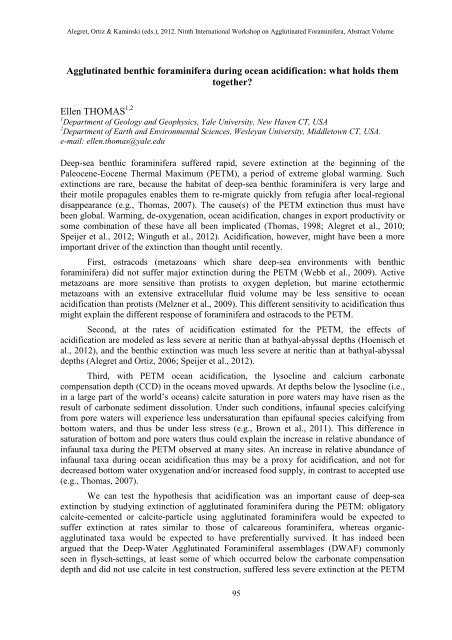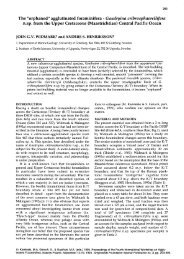Full Text | Download - Grzybowski Foundation - The ...
Full Text | Download - Grzybowski Foundation - The ...
Full Text | Download - Grzybowski Foundation - The ...
You also want an ePaper? Increase the reach of your titles
YUMPU automatically turns print PDFs into web optimized ePapers that Google loves.
Alegret, Ortiz & Kaminski (eds.), 2012. Ninth International Workshop on Agglutinated Foraminifera, Abstract Volume<br />
Agglutinated benthic foraminifera during ocean acidification: what holds them<br />
together?<br />
Ellen THOMAS 1,2<br />
1<br />
Department of Geology and Geophysics, Yale University, New Haven CT, USA<br />
2<br />
Department of Earth and Environmental Sciences, Wesleyan University, Middletown CT, USA.<br />
e-mail: ellen.thomas@yale.edu<br />
Deep-sea benthic foraminifera suffered rapid, severe extinction at the beginning of the<br />
Paleocene-Eocene <strong>The</strong>rmal Maximum (PETM), a period of extreme global warming. Such<br />
extinctions are rare, because the habitat of deep-sea benthic foraminifera is very large and<br />
their motile propagules enables them to re-migrate quickly from refugia after local-regional<br />
disappearance (e.g., Thomas, 2007). <strong>The</strong> cause(s) of the PETM extinction thus must have<br />
been global. Warming, de-oxygenation, ocean acidification, changes in export productivity or<br />
some combination of these have all been implicated (Thomas, 1998; Alegret et al., 2010;<br />
Speijer et al., 2012; Winguth et al., 2012). Acidification, however, might have been a more<br />
important driver of the extinction than thought until recently.<br />
First, ostracods (metazoans which share deep-sea environments with benthic<br />
foraminifera) did not suffer major extinction during the PETM (Webb et al., 2009). Active<br />
metazoans are more sensitive than protists to oxygen depletion, but marine ectothermic<br />
metazoans with an extensive extracellular fluid volume may be less sensitive to ocean<br />
acidification than protists (Melzner et al., 2009). This different sensitivity to acidification thus<br />
might explain the different response of foraminifera and ostracods to the PETM.<br />
Second, at the rates of acidification estimated for the PETM, the effects of<br />
acidification are modeled as less severe at neritic than at bathyal-abyssal depths (Hoenisch et<br />
al., 2012), and the benthic extinction was much less severe at neritic than at bathyal-abyssal<br />
depths (Alegret and Ortiz, 2006; Speijer et al., 2012).<br />
Third, with PETM ocean acidification, the lysocline and calcium carbonate<br />
compensation depth (CCD) in the oceans moved upwards. At depths below the lysocline (i.e.,<br />
in a large part of the world’s oceans) calcite saturation in pore waters may have risen as the<br />
result of carbonate sediment dissolution. Under such conditions, infaunal species calcifying<br />
from pore waters will experience less undersaturation than epifaunal species calcifying from<br />
bottom waters, and thus be under less stress (e.g., Brown et al., 2011). This difference in<br />
saturation of bottom and pore waters thus could explain the increase in relative abundance of<br />
infaunal taxa during the PETM observed at many sites. An increase in relative abundance of<br />
infaunal taxa during ocean acidification thus may be a proxy for acidification, and not for<br />
decreased bottom water oxygenation and/or increased food supply, in contrast to accepted use<br />
(e.g., Thomas, 2007).<br />
We can test the hypothesis that acidification was an important cause of deep-sea<br />
extinction by studying extinction of agglutinated foraminifera during the PETM: obligatory<br />
calcite-cemented or calcite-particle using agglutinated foraminifera would be expected to<br />
suffer extinction at rates similar to those of calcareous foraminifera, whereas organicagglutinated<br />
taxa would be expected to have preferentially survived. It has indeed been<br />
argued that the Deep-Water Agglutinated Foraminiferal assemblages (DWAF) commonly<br />
seen in flysch-settings, at least some of which occurred below the carbonate compensation<br />
depth and did not use calcite in test construction, suffered less severe extinction at the PETM<br />
95



